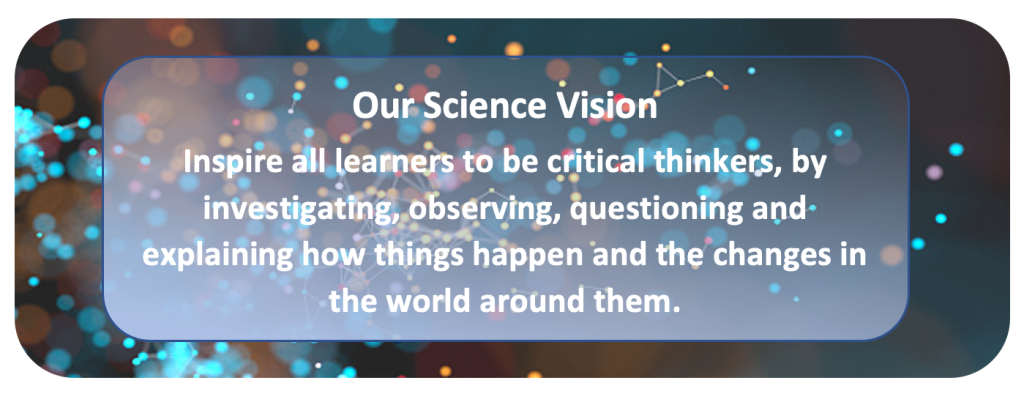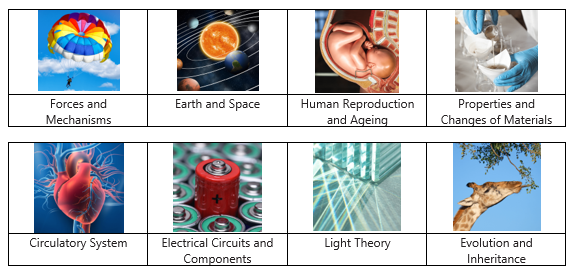
"Science is all around us!"
Maja Coom
"Science is the observation, experimentation and explanation of the world around us."
Delilah Dodds

At Boscastle we recognise the importance of Science and strive to maintain a high profile for the subject within our school. Our desire to empower and motivate children to develop a lifelong love of science is reflected in our curriculum and nurturing learning environments.
A scientist observes, questions, creates theories, experiments, records data, and then analyses that data. All children can be scientists by following their own natural curiosity, and at Boscastle, teachers help to build and reinforce these skills so that children are able to thrive and achieve.
We aspire to provide excellent opportunities for Science so that children can:
By providing these opportunities, we ensure that our children are inspired, confident, life-long learners who will continue to explore the world around them, way beyond their time at primary school.

Our Science Curriculum
Throughout the science scheme, there is complete coverage of all national curriculum programmes of study. Science projects are sequenced to develop both children’s substantive and declarative knowledge, and if possible, make meaningful links to other projects. For example, in Lower KS2 Cycle B, the projects Plant Nutrition and Reproduction and Light and Shadows are taught alongside the design and technology project Greenhouse and the art and design project Beautiful Botanicals. These links allow for children to embed their substantive knowledge in new and often real-life contexts.
The sequencing of projects ensures that children have the substantive knowledge and vocabulary to comprehend subsequent projects fully. Each project’s place in the year has also been carefully considered. For example, projects that involve growing plants or observing animals are positioned at a suitable time of year to give children the best possible opportunity to make first-hand observations. Within all the science projects, disciplinary knowledge is embedded within substantive content.
Key Stage 1

In Cycle A, children begin the autumn term with the project Human Survival, learning about the survival needs of humans, before expanding to study animals within their habitats in the project Habitats. Building on previous learning, children learn about the uses of materials in the spring project Uses of Materials and begin to understand changes of materials through simple physical manipulation, such as bending and twisting. The spring Plant Survival project also explores survival, with children observing what plants need to grow and stay healthy. Finally, in the project Animal Survival, children bring together learning from the autumn term, thinking about what animals need to survive.
In Cycle B, children start the autumn term with Everyday Materials, linking this learning to the design and technology project Shade and Shelter. In the Human Senses project, they learn about parts of the human body and those associated with the senses. In the spring project Seasonal Changes, they learn broadly about seasonal changes linked to weather, living things and day length. They revisit some of this learning in the following summer term project Plant Parts. They finish with the project Animal Parts, linking back to their knowledge about body parts and senses and identifying commonalities.
Lower Key Stage 2

Having learned about human body parts, the senses and survival in Key Stage 1, children now focus on specific body systems and nutrition in Key Stage 2. In the autumn term of Cycle A, they learn about the digestive system, again making comparisons to other animals, in the project Digestive System. The second autumn term project Sound introduces the concept of sound, with children identifying how sounds are made and travel. They learn and use new vocabulary, such as pitch and volume, and identify properties of materials associated with these concepts. In the spring term project States of Matter, children learn about solids, liquids and gases and their characteristics. They understand how temperature drives change of state and link this learning to the project Misty Mountain, Winding River, in which children learn about the water cycle. Up to this point, children have had many opportunities for grouping and sorting living things. In the spring project Grouping and Classifying, children recognise this as ‘classification’ and explore classification keys. Finally, in the summer term, children study electricity by creating and recording simple circuits in the project Electrical Circuits and Conductors. They also build on their knowledge of the properties of materials, identifying electrical conductors and insulators.
In the autumn term of Cycle B, children learn about the skeletal and muscular system in the project Skeletal and Muscular Systems. This learning again links to other animals, with children identifying similarities and differences. Children also learn about healthy diets alongside the autumn term design and technology project Cook Well, Eatwell. In the spring term, properties of materials are revisited in the project Forces and Magnets, with children identifying magnetic materials and learning about the non-contact force of magnetism. They also begin to learn about contact forces, investigating how things move over surfaces. Science learning about rocks and soils is delivered through the geography project Rocks, Relics and Rumbles. Children begin to link structure to function in the summer Plant Nutrition and Reproduction project, identifying the plant parts associated with reproduction and water transport. Children finish the year with the project Light and Shadows, where they are explicitly introduced to the subject of light, with children learning about shadows and reflections, revisiting language from Key Stage 1, including opaque and transparent.
Upper Key Stage 2

In the autumn term of Cycle A, children broaden their knowledge of forces, including gravity and air and water resistance, in the project Forces and Mechanisms. They revisit learning from design and technology projects, including Making It Move and Moving Mechanisms, to explore various mechanisms and their uses. Their knowledge of gravity supports the autumn term project Earth and Space, so they can understand the forces that shape planets and our solar system. They also develop their understanding of day and night, first explored in the Year 1 project Seasonal Changes. Having learned that animals and plants produce offspring in earlier projects and studied plant and animal life cycles in Sow, Grow and Farm, children now focus on the human life cycle and sexual reproduction in the spring term project Human Reproduction and Ageing. In the summer term project Properties and Changes of Materials, children revisit much of their prior learning about materials’ properties and learn new properties, including thermal conductivity and solubility. To this point, children have learned much about reversible changes, such as melting and freezing, but now extend their learning to irreversible changes, including chemical changes.
In Cycle B, the final body system children learn about is the circulatory system and its roles in transporting water, nutrients and gases in the autumn term project Circulatory System. Science learning about classification is delivered through the spring term geography project Frozen Kingdoms. In the spring term, children also build on their knowledge about electrical circuits from Lower KS2, now learning and recording standard symbols for circuit components and investigating the function of components and the effects of voltage on a circuit in the project Electrical Circuits and Components. In the summer project Light Theory, children recognise that light travels in straight lines from a source or reflector to the eye and explain the shape of shadows. Finally, in the project Evolution and Inheritance, children learn about inheritance and understand why offspring are not identical to their parents. They also learn about natural selection and how this can lead to the evolution of a species.
Fore Street
Boscastle
Cornwall
PL35 0AU

| Cookie | Duration | Description |
|---|---|---|
| cookielawinfo-checkbox-analytics | 11 months | This cookie is set by GDPR Cookie Consent plugin. The cookie is used to store the user consent for the cookies in the category "Analytics". |
| cookielawinfo-checkbox-functional | 11 months | The cookie is set by GDPR cookie consent to record the user consent for the cookies in the category "Functional". |
| cookielawinfo-checkbox-necessary | 11 months | This cookie is set by GDPR Cookie Consent plugin. The cookies is used to store the user consent for the cookies in the category "Necessary". |
| cookielawinfo-checkbox-others | 11 months | This cookie is set by GDPR Cookie Consent plugin. The cookie is used to store the user consent for the cookies in the category "Other. |
| cookielawinfo-checkbox-performance | 11 months | This cookie is set by GDPR Cookie Consent plugin. The cookie is used to store the user consent for the cookies in the category "Performance". |
| viewed_cookie_policy | 11 months | The cookie is set by the GDPR Cookie Consent plugin and is used to store whether or not user has consented to the use of cookies. It does not store any personal data. |